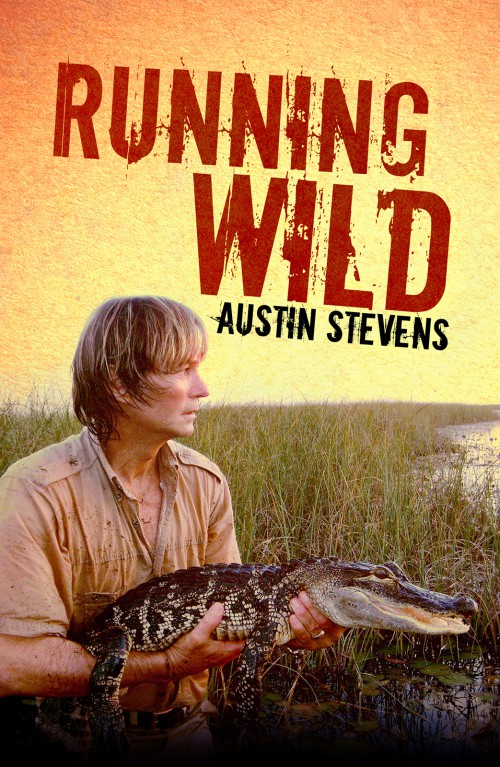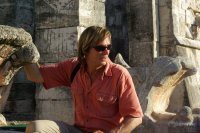
By: Austin Stevens
*Available directly from our distributors, click the Available On tab below

Originally from South Africa, wildlife photographer, film maker, author, and adventurer, Austin Stevens is best known for his hit TV shows, Snakemaster, Austin Stevens Most Dangerous, and Austin Stevens Adventures, on Animal Planet, Discovery Channel, National Geographic Channel and Channel 5 UK. Running Wild is Austin’s 4th and most personally revealing book to date. He presently resides in Australia, with his wife, Amy.
In the 1960's Austin Stevens was helping manage animals at parks (especially the reptile parks) and getting up to all kinds of adventures. From being face to face with an angry and scared male chimp (very dangerous) to spending 108 days in a transparent cage full of cobras and a black mamba Austin Stevens has had some big adventures- and some big hurts. Hit by a car by a drunk drivers, stabbed by an angry gardener (who was upset about being told off for beating a maid), and I'm sure there's more (as I'm only 3/4 way through the book) Mr Stevens is candid about how he felt during his experiences. But a streak of resilience runs through the book and it seems you couldn't knock down his 'get up and go' for long.I didn''t expect to find the book so compelling but it's a real page turner, even just to shake your head at the crazy things he got involved in. The time he spent weeks pursuing a female chameleon (even when everyone else said they were too boring to be of interest in a nature program) was especially interesting (and encouraging if you are pursuing something new. Austin is not to be confused with the Australian Steve Irwin who died after being stung by a Stingray. An unconventionally enjoyable book with a fresh and crispy narrative - it makes me want to have more adventures myself!
I am very happy i had the possibility to read Running Wild, it confirms what i could only imagine by watching him a day in tv in his adventures, the question, that still is without answer, “Who the Snakemaster really is ?”returns during the reading, also that of his previous original books, because of the many inspirations he transmits with the renowned recorded demonstrations in the wild, the engagement in conservation's politics and experience in the fields, the evolutions in photographing and writing. He often asks what would be for a reader the true wish for a travel or discovering something new, showing so how nature is a mirror for himself and offers infinite ways for unexpected dreams. While remembering the tragic situation ecosystem is suffering, he uses poetical messages through a very direct, and very useful, speech, examples of which are the description of the Amazon River's story, the calm he learnt during the encounters with many species, the intelligence and curiosity of the king snake but also the accounts of the journeys which brought him to realize his personality, as for the case of the documentary of chameleons, and which needed total concentration. Speaking about his experiences in war, he reflects more in general upon the necessity of the right means for important purposes, and moreover in the case of entering completely wild places and their fauna, i find the ancient doubt whether a camera can protect by documenting thus allowing a habitat to be for ever intact and safe. I love the explanation on animals' camouflage, for this, maybe, i find in his style of writing many qualities of those protagonists of his stories: determination, lightness, strength, wisdom, together with the symbiosis with the natural environments: sand dunes, starry sky in the nights, rocks and the personal skill to detect traces!
I have read Austin’s Stevens snakemaster, as well as this. Both were brilliantly absorbing reads but this definitely cut the cake for me. Being able to read more into Austin’s past and beyond that of photographing animals was very interesting. The insight was humbling and I finished the book in one read. It was never put down. Holy Mackerel!
Austin Stevens became famous for sharing a glass cage with venomous snakes for one-hundred and seven days, breaking the Guinness World record for carrying out such a crazy stunt. We South Africans would wake up and immediately turn on the news each morning that he was doing this “sharing” to find out if he’d survived another night and give a cheer to hear he was still alive. It struck a nerve with me because of my absolute phobia of snakes and the idea of sleeping, eating and trying to live a normal life while being eye-balled by these very deadly reptiles sent shivers through me each day.
But it wasn’t just his passion for snakes that made him famous. Everyone who visited the centre where he worked at Hartbeespoort Dam, not that far from Pretoria in Gauteng, got to know him. That’s why when he was stopped for speeding after collecting a particularly angry python, you would have expected that the police who stopped him would recognise his name and believe his story that he had an angry, very long python sitting in his boot. His story was not accepted, so he let them open the boot. The angry python with a mouth full of teeth flew out the minute the officers opened the boot, and the poor man (really? Why am I feeling sorry for him?) suddenly felt its teeth latch on, and the snake immediately started to coil around him.
Austin Stevens tells many such stories in a similar vein that are uproariously funny. However, there is a sombre side to the book as well. He describes being called up for National Service when the war against the military wing of the ANC turned from skirmishes into a full-blown war on the border of Namibia and Angola. He found himself questioning why the South African government wouldn’t negotiate with the ANC. After returning home to his somewhat remote dwelling, he faced a new threat – the house being attacked by burglars time and again. Living behind bars on all the windows and security doors covering all exterior doors was not the life he wanted to live and he decided to leave South Africa and get into making documentaries and develop his photography, which had already received much praise.
This new profession took him not only to the remotest parts of Africa but also other continents and led to a series of programmes being made for National Geographic, Planet Earth and the Discovery Channels
Austin Stevens memoirs are fascinating. As a South African, I can relate to many aspects of his life. Hartbeespoort Dam was where we spent a lot of our time as youngsters as it was near Pretoria where I grew up.
Imbali
Breakaway Reviewers received a copy of the book to review.
I am very happy i had the possibility to read Running Wild, it confirms what i could only imagine by watching him a day in tv in his adventures, the question, that still is without answer, “Who the Snakemaster really is ?”returns during the reading, also that of his previous original books, because of the many inspirations he transmits with the renowned recorded demonstrations in the wild, the engagement in conservation's politics and experience in the fields, the evolutions in photographing and writing. He often asks what would be for a reader the true wish for a travel or discovering something new, showing so how nature is a mirror for himself and offers infinite ways for unexpected dreams. While remembering the tragic situation ecosystem is suffering, he uses poetical messages through a very direct, and very useful, speech, examples of which are the description of the Amazon River's story, the calm he learnt during the encounters with many species, the intelligence and curiosity of the king snake but also the accounts of the journeys which brought him to realize his personality, as for the case of the documentary of chameleons, and which needed total concentration. Speaking about his experiences in war, he reflects more in general upon the necessity of the right means for important purposes, and moreover in the case of entering completely wild places and their fauna, i find the ancient doubt whether a camera can protect by documenting thus allowing a habitat to be for ever intact and safe.
I love the explanation on animals' camouflage, for this, maybe, i find in his style of writing many qualities of those protagonists of his stories: determination, lightness, strenght, wisdom, together with the symbiosis with the natural environments: sand dunes, starry sky in the nights, rocks and the personal skill to detect traces!
Any fan of Austin Stevens who has read all of his previous books or watched his TV programs will enjoy this book. He added personal details to his life as an adventurer past and present will have you at times on edge in wonder... how did he survive?
We use cookies on this site to enhance your user experience and for marketing purposes.
By clicking any link on this page you are giving your consent for us to set cookies